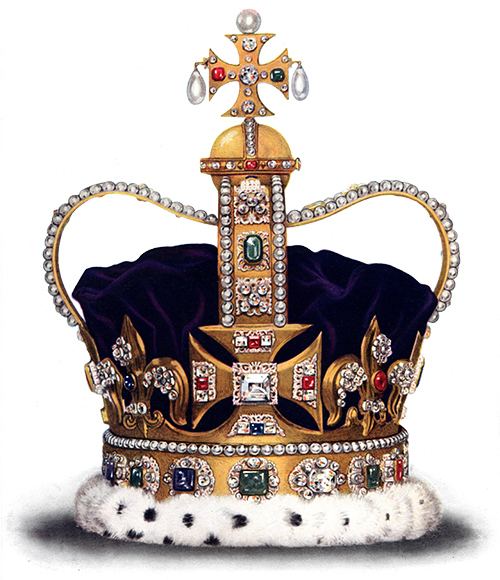Weight 2.23 kg (4.9 lb) Material Gold | Made 1661 (current version) Arches 2 | |
 | ||
Owner Queen Elizabeth II in right of the Crown. | ||
St Edward's Crown is one of the oldest Crown Jewels of the United Kingdom and the centrepiece of the coronation regalia. Named after Edward the Confessor, it has traditionally been used to crown English and British monarchs at their coronation ceremonies. The current version was made for the coronation of Charles II in 1661.
Contents
Medieval version
Edward the Confessor wore the original crown at Easter, Whitsun and Christmas. It may have incorporated elements of a crown that belonged to Alfred the Great. In 1066, St Edward's Crown was reputedly used at the coronation of William the Conqueror. It was subsequently used for the coronations of William II (1087), Henry I (1100), Stephen (1135), Henry II (1154), Richard I (1189 and 1194) and King John (1199).
At the first coronation of Henry III in 1216, a chaplet was used instead of the crown. From this it was inferred by the German historian, Reinhold Pauli, that the original St Edward's Crown had been among the jewels lost by King John. However, Arthur Penrhyn Stanley maintained that the original crown and regalia were kept in the Treasury until the time of Henry VIII, and survived until 1642. It was supposedly used in 1533 to crown the second wife of Henry VIII, Anne Boleyn – unprecedented for a queen consort.
During the English Civil War in 1642, Parliament sold the medieval St Edward's Crown, regarded by Oliver Cromwell as symbolic of the "detestable rule of kings".
Current version
The British monarchy was eventually restored in 1661, and in preparation for the coronation of Charles II, a new St Edward's Crown was made by Sir Robert Vyner. It is 30 cm (12 in) tall and weighs 2.23 kg (4.9 lb), and has four fleurs-de-lis and four crosses pattée, supporting two dipped arches topped by a monde and cross pattée. Its purple velvet cap is trimmed with ermine.
In 1671, Colonel Thomas Blood briefly stole the crown from the Tower of London, flattening it with a mallet in an attempt to conceal it.
A new monde was created for the coronation of James II, and for William III the base was changed from a circle to an oval.
St Edward's Crown was placed on the coffin of Edward VII for his lying in state and funeral in 1910.
Jewels would be hired for use in the crown and removed after the coronation until 1911, when it was permanently set with 444 semi-precious stones, including 345 rose-cut aquamarines, 37 white topazes, 27 tourmalines, 12 rubies, 7 amethysts, 6 sapphires, 2 jargoons, 1 garnet, 1 spinel and 1 carbuncle. Imitation pearls on the arches and base were replaced with golden beads. It was also made smaller to fit George V, the first monarch to be crowned with St Edward's Crown in over 200 years.
On 4 June 2013, the crown was displayed on the altar in Westminster Abbey to mark the 60th anniversary of Queen Elizabeth II's coronation – the first time it had left the Jewel House at the Tower of London since 1953.
At coronations
Although it is regarded as the official coronation crown, only six monarchs have been crowned with St Edward's Crown since the Restoration: Charles II (1661), James II (1685), William III (1689), George V (1911), George VI (1937) and Queen Elizabeth II (1953). Mary II and Queen Anne were crowned with small diamond crowns of their own; George I, George II, George III and William IV with the State Crown of George I; George IV with a large new diamond crown made specially for the occasion; and Queen Victoria and Edward VII chose not to use St Edward's Crown because of its weight and instead used the lighter 1838 version of the Imperial State Crown. When not used to crown the monarch, St Edward's Crown was placed on the altar during the coronation; however, it did not feature at all at the coronation of Queen Victoria.
Before 1649, it was usual for a monarch to be crowned with the original St Edward's Crown, and often had several crowns placed on his or her head during the ceremony.
In heraldry
Images based on the crown are used in coats of arms, badges, logos and various other insignia throughout the Commonwealth realms to symbolise the monarch's royal authority. In these contexts, it replaced the Tudor Crown (used since 1902) in 1953 by order of Queen Elizabeth II. Use of the crown's image in this way is by permission of the monarch.
